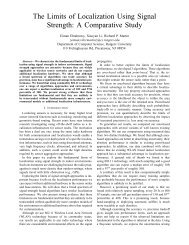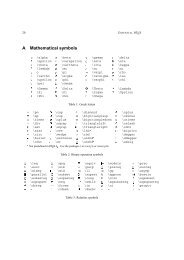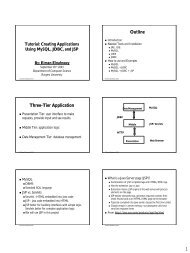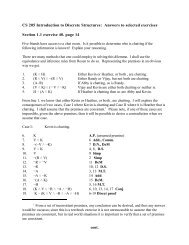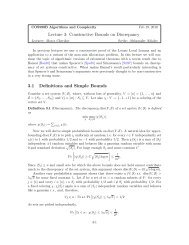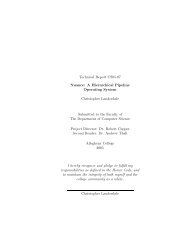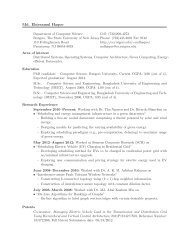Matching Schemas From Disparate Data Sources
Matching Schemas From Disparate Data Sources
Matching Schemas From Disparate Data Sources
Create successful ePaper yourself
Turn your PDF publications into a flip-book with our unique Google optimized e-Paper software.
<strong>Matching</strong> <strong>Schemas</strong><strong>From</strong> <strong>Disparate</strong><strong>Data</strong> <strong>Sources</strong>Eiman Elnahrawy(Rutgers University, eiman@cs.rutgers.edu)Under supervision ofPhilip Bohannon & Michael Flaster
<strong>Data</strong>..<strong>Data</strong>.. and more <strong>Data</strong> !!• Explosion of information and datasources• Need to ultimately benefit from eachpiece of data
What is Semantic <strong>Matching</strong>?• Mapping schema elements in one informationrepository to corresponding elements in asecond repository– Integrating diverse set of queryable infosources over• The web (e.g., Inventory)• Enterprise data
15430,000Raleigh,NC32360,000Atlanta,GAAgentIdPrice($)locationMikeBrownAthens,GA370,800Atlanta,GALauraSmithBoulder,CO550,000Denver,COAgentnameAgentaddresspricearea0.04NCRaleighJean Laup150.03GAAthensMike Brown32fee-ratestatecitynameIdSchema SSchema T
Schema Sfantastic house 250,000 15 729-0831 Atlanta GA 15 250,000 $ Schema T Atlanta, GA Laura Smith
Why do we care?• Our main concern is network data• E.g., how to map data from SNMP intoNetML?• Not quite a new problem..!
Manual integration is notpractical• <strong>Schemas</strong> can be quite large(tedious, error-prone, ..)• No documentation or meta dataavailable sometimes!!?• Poor design: exact semantics notknown or fully captured in theschema• Schema structure may repeatedlychange over the timeCannot be fully automated but at least to a large extent..(Semi-Automatic)
Outline• Introduction and motivations• What is Schema <strong>Matching</strong>?• State of the Art in <strong>Matching</strong> <strong>Schemas</strong> fromDiverse <strong>Sources</strong>• Our Prototype.. Our Goals..• Conclusions and Future Work
• <strong>Matching</strong> Accuracy!Key Challenges• Smart ideas to exclude unnecessary matching• How to match (semi)structured data or data withdifferent designs (column name may be a data field!)• Reflect/guarantee domain constraints in the match• Complex matches 1-to-M (fns of multiple columns)• Time complexity (schemas may have thousands attr)
Related Work• Description of data in column (data-type):– Categorize attributes according to fieldspecifications and data values– Train a neural network to recognize similarattributes (attribute category)[Li and Clifton VLDB94]
• Training/domain expert:– Ask users to match samples– Use these to train a set of learners– Find mappings using trained learners– Combine predictions using a meta learner[Doan, Domingos and Halevy SIGMOD01]• Something somewhat similar[Berlin and Motro CAiSE02]• Building a matching corpus:– Explore evidence from other matching problemsin a matching corpus[Madhaven, Bernstein et al ICDE05]
• Information theory-based:– Column names can be opaque!– Construct dependency graph using mutualinformation between columns– Reduces to a graph matching problem[Kang and Naughton SIGMOD03]• Rule-based (iMAP):– Search space of all possible matches“efficiently”– Apply rules that reflect domain constraints[Dhamanker, Lee, Doan et al SIGMOD04]
• Fragment-oriented:– Decompose XML trees into much smallersub-trees and match from bottom up[Rahm et al ACM SIGMOD Records04]• <strong>Matching</strong> different designs -- values asattribute names:– Extends SQL to promote and demoteattribute names[Wyss, Fletcher et al. ACM trans on DB05 ]
Our Prototype.. Our Goal..• Preliminary test-bed in Java with a reasonablecollection of matchers• To be extended by integrating more matchingapproaches• Tool to investigate/evaluate different approachesusing “appropriate” performance metrics– Speed, Accuracy (Precision versus Recall)
Design• A collection of matchers that works on datasummaries• Numeric, Categorized and Text-based data
SourceTargetCreate Summaries…..Matcher Matcher…..Matcher• Go over the source andcreate all summaries inthe “summary factory”• Repeat for target• Match columns usingsummaries and computematching confidence• If [confidence >threshold] -> columnsmatchabcFilterbka• Filter overall matchresults and display Top-kmatches for each targetelementdlec
• Name Matcher (Exact, Levenshtein distance )• Histogram Matcher (Kullback-Leibler distance)• Bayesian Classifier (NN to be integrated)[http://classifier4j.sourceforge.net/usage.htm]• Value Set Matcher• Different Tokenizers (Qgrams, non-word break,white-space break)• Type Matcher (calendar, phone #, zip code,general strings, numbers, ..)
Supported Features• One-to-one mapping• Try-everything strategy with type checking• Fixed threshold, although doesn’t reallymatter• Filter results by choosing top-k columns fromsource that match target
Conclusion• Schema matching is the problem of identifyingcorresponding elements in different schemas• A challenging problem• Very active area of research with variousmarket applications• Working prototype• Different matchers, combine results usingsome strategies
Future Work• More work on the prototype– Study performance (metrics) of differentmatchers (what works best on which data)– Better filtering of matching results– Large test data– Opaque column matching!– Learning over time to better match, setthresholds
Thanks! ☺Any Q?




